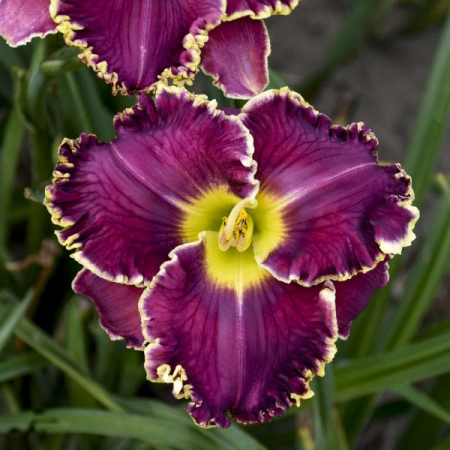Hemerocallis (Daylily)
×
Color Name: Cosmic Struggle
Stunningly intense, rich wine purple flowers are lined neatly with a lemon-yellow picotee edge. The purple color holds up well and does not fade. The lined margins accentuate the color for an incredibly attractive look. A subtle, dark lavender watermark above the eye.
Daylilies can survive many harsh conditions that other plants cannot including: polluted city environments, slopes, poor and dry soils, near pavement that is salted in winter, and under Black Walnut trees (not affected by juglone).
Growing Tips: Daylilies are some of the easiest perennials to grow and are a good choice for any gardener, from the beginner to the professional. These are tough, adaptable plants that will grow in any soil, from normal to slightly wet to dry. Older varieties are able to bloom if planted in partial shade, but most of the newer introductions need full sun for best performance. Likewise, older varieties tend to spread more rapidly than the newer hybrids. All varieties can be divided every 3-4 years by digging up the entire clump and dividing it into smaller pieces with a minimum of 3 eyes each. This can be done in either spring or fall. Plants should be deadheaded for cosmetic purposes, but in most cases this will not extend the bloom time.
Photo courtesy of Walters Garden, Inc.
Stunningly intense, rich wine purple flowers are lined neatly with a lemon-yellow picotee edge. The purple color holds up well and does not fade. The lined margins accentuate the color for an incredibly attractive look. A subtle, dark lavender watermark above the eye.
Daylilies can survive many harsh conditions that other plants cannot including: polluted city environments, slopes, poor and dry soils, near pavement that is salted in winter, and under Black Walnut trees (not affected by juglone).
Growing Tips: Daylilies are some of the easiest perennials to grow and are a good choice for any gardener, from the beginner to the professional. These are tough, adaptable plants that will grow in any soil, from normal to slightly wet to dry. Older varieties are able to bloom if planted in partial shade, but most of the newer introductions need full sun for best performance. Likewise, older varieties tend to spread more rapidly than the newer hybrids. All varieties can be divided every 3-4 years by digging up the entire clump and dividing it into smaller pieces with a minimum of 3 eyes each. This can be done in either spring or fall. Plants should be deadheaded for cosmetic purposes, but in most cases this will not extend the bloom time.
Photo courtesy of Walters Garden, Inc.
|
Flower Color: Purple Shades Foliage Color: Green Shades
Height: 20 to 30 Inches Spread: 15 to 25 Inches Hardy in Zone: 4, 5, 6 |
Blooms: Summer to Fall
Foliage Season: All Season |
Growth Rate |
Medium
|
Attributes |
Extended Bloomer Salt Tolerant Mass Planting Landscapes Cut Flower or Foilage Specimen Plant Easy to Grow Drought Tolerant Border
|









